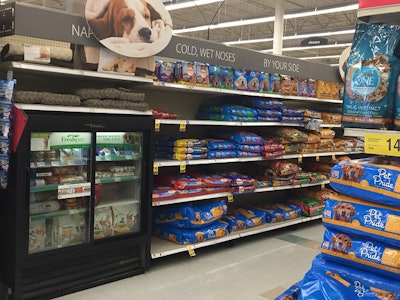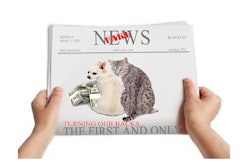
The U.S. pet food market reached US$36.61 billion in sales in 2019, according to information presented by David Sprinkle, research director for Packaged Facts, at Global Pet Expo (GPE) in Orlando on February 26. That represented 6.1% growth from 2018; Packaged Facts projects the market to grow at a compound annual rate of 3.2% through 2024.
Note that this data differs slightly from that released by the American Pet Products Association (APPA), organizer of GPE, during the show. The difference between APPA’s data and that from research firms like Packaged Facts is not as large as it has been in previous years because APPA changed its methodology for collecting and analyzing data on the U.S. pet care market, now using a compilation of information from the research firms.
Still, all the numbers are very close and signal good news for the industry. That doesn’t mean significant changes aren’t continuing to disrupt the market, particularly when it comes to where, when and how pet owners buy pet food and other pet products and services – the focus of Sprinkle’s presentation and what he called “omnichannel.” (He will present on a related topic, “How and why consumers switch and mix pet food choices,” at Petfood Forum 2020 on April 29.)
No surprise: Online pet product sales soaring
By now, it’s a familiar tale: Online sales of pet products (along with just about every other kind of product) continue to soar, growing healthily each year. In 2015, internet sales of pet products hit US$3.17 billion, a 7% share of the U.S. pet market. By 2019, that figure had leaped to US$12.25 billion, a 22% share, Sprinkle said. Packaged Facts projects e-commerce’s share to hit at least 24% by 2024, reaching US$18.21 in sales.
By comparison, while sales in other channels such as pet chains and food stores (as in traditional grocery markets and stores, I believe) have increased along with the overall growth of the market, their shares have declined, from 16% in 2015 to 12% in 2019 for pet chains, and 24% in 2015 to 21% in 2019 for food stores.
Still, pet stores, especially chains, still represent the second largest channel for pet food sales, at US$11.88 billion in 2019. Just behind that channel is mass market – for example, mass merchandisers and supercenters such as Walmart and Target, and wholesale club stores including Costco and Sam’s Club – at US$11.36 in pet product sales and a 21% share, which has remained steady since 2015.
The data aligns with the sources U.S. pet owners turn to most for information on pet care, according to preliminary results from a February 2020 study of consumers conducted by Packaged Facts. Though the highest percentage of owners, in all age groups, consult their veterinarians the most, the internet (excluding social media) ranks second or third for all age groups, exchanging places with pet specialty stores depending on the group.
For example, 40% of 18- to 34-year-old owners consult the internet, yet 41% (rather surprisingly) also seek information from pet specialty stores. For 35- to 54-year-olds, the percentage is the same (39%) for the internet or pet stores as an information source, while for 55+-year-olds, the internet is actually more important, at 34% vs. 26% for pet stores.
Mass market’s influence and relationship to online
Despite the popularity and growth of the internet, mass market may be the most interesting channel today in terms of understanding where pet owners shop. “This is a market ripe with intriguing paradox, and much of that paradox stems from the performance of mass market stores,” Sprinkle said in a press release for Packaged Facts’ newest report, “U.S. Pet Market Focus: Mass Market Channel Shoppers.”
Packaged Facts gave two reasons for this situation. First, premium and superpremium pet foods are now prevalent in mass market retailers, in addition to pet specialty stores, their traditional channel, as well as online.
“Secondly, while e-commerce has clearly grown the overall market and not merely cannibalized sales, there has nonetheless been an element of robbing pet stores to pay Paul,” said Packaged Facts and Sprinkle. They refer to survey data in their new report showing that, for brick-and-mortar retailers, pet superstores have taken the most direct blow from e-commerce, based on the number and percentage of their customer base who also buy pet products online.
That has helped the mass market channel. Perhaps a magazine covering the channel, DSN, provides the best context: “Pet is now more than a category. It holds the key to customer engagement across the store,” read an April 2019 article (quoted by Sprinkle in his presentation).
The veterinary and fresh pet food factors
Though Sprinkle’s overall channel sales data did not include data veterinary clinics, he did identify vets as having a more direct role in pet food product development, marketing and sales. One example he gave results directly from the Food and Drug Administration’s (FDA) investigation into a possible link between canine dilated cardiomyopathy (DCM) and grain-free pet foods. “In the wake of DCM, veterinary diets strike back,” as Sprinkle put it.
He also included veterinarians in the partnerships springing up, also among manufacturers and retailers, as part of “omnimarket” strategies, often leading to product and service pairings. For example, JustFoodforDogs not only has partnered with Petco by having kitchens within the chain’s stores; it also touts the number of veterinarians on staff at the dog food company (14, including five on-staff, three consultants and six formulators, according to the company).*
As a fresh type of pet food, JustFoodforDogs joins others identified by Sprinkle as signs that this format could become the new, standard for superpremium pet food. These products now appear in every channel, online especially, with subscription models for fresh pet food offerings (e.g., the Farmers Dog). But the channel spread also includes mass market; think of Freshpet refrigerators and freezers in Walmart or grocery stores. In fact, Sprinkle asked: Could fresh be the next supermarket innovation frontier?
*Editor’s note: The numbers of veterinarians working with JustFoodForDogs has been updated, based on information provided by the company.

















